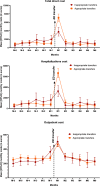Cost of care pathways before and after appropriate and inappropriate transfers to the emergency department among nursing home residents: results from the FINE study
- PMID: 38641801
- PMCID: PMC11027376
- DOI: 10.1186/s12877-024-04946-x
Cost of care pathways before and after appropriate and inappropriate transfers to the emergency department among nursing home residents: results from the FINE study
Abstract
Background: Transfers of nursing home (NH) residents to the emergency department (ED) is frequent. Our main objective was to assess the cost of care pathways 6 months before and after the transfer to the emergency department among NH residents, according to the type of transfer (i.e. appropriate or inappropriate).
Methods: This was a part of an observational, multicenter, case-control study: the Factors associated with INappropriate transfer to the Emergency department among nursing home residents (FINE) study. Sixteen public hospitals of the former Midi-Pyrénées region participated in recruitment, in 2016. During the inclusion period, all NH residents arriving at the ED were included. A pluri-disciplinary team categorized each transfer to the ED into 2 groups: appropriate or inappropriate. Direct medical and nonmedical costs were assessed from the French Health Insurance (FHI) perspective. Healthcare resources were retrospectively gathered from the FHI database and valued using the tariffs reimbursed by the FHI. Costs were recorded over a 6-month period before and after transfer to the ED. Other variables were used for analysis: sex, age, Charlson score, season, death and presence inside the NH of a coordinating physician or a geriatric nursing assistant.
Results: Among the 1037 patients initially included in the FINE study, 616 who were listed in the FHI database were included in this economic study. Among them, 132 (21.4%) had an inappropriate transfer to the ED. In the 6 months before ED transfer, total direct costs on average amounted to 8,145€ vs. 6,493€ in the inappropriate and appropriate transfer groups, respectively. In the 6 months after ED transfer, they amounted on average to 9,050€ vs. 12,094€.
Conclusions: Total costs on average are higher after transfer to the ED, but there is no significant increase in healthcare expenditure with inappropriate ED transfer. Support for NH staff and better pathways of care could be necessary to reduce healthcare expenditures in NH residents.
Trial registration: clinicaltrials.gov, NCT02677272.
Keywords: Cost; Economics; Long-term care unit; Nursing home; Transfer to emergency department.
© 2024. The Author(s).
Conflict of interest statement
The authors declare no competing interests.
Figures




References
-
- Ageing and health. Disponible sur: https://www.who.int/news-room/fact-sheets/detail/ageing-and-health. Consulté le: 9 Juil 2021.
-
- Population par âge − Tableaux de l’économie française | Insee. Disponible sur: https://www.insee.fr/fr/statistiques/3303333?sommaire=3353488. Consulté le: 9 Juil 2021.
-
- L’enquête auprès des établissements d’hébergement pour personnes âgées (EHPA) | Direction de la recherche, des études, de l’évaluation et des statistiques. Disponible sur: https://drees.solidarites-sante.gouv.fr/sources-outils-et-enquetes/07-le.... Consulté le: 9 Juil 2021.
Publication types
MeSH terms
Associated data
LinkOut - more resources
Full Text Sources
Medical

